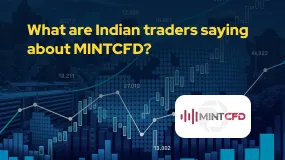简体中文
繁體中文
English
Pусский
日本語
ภาษาไทย
Tiếng Việt
Bahasa Indonesia
Español
हिन्दी
Filippiiniläinen
Français
Deutsch
Português
Türkçe
한국어
العربية
What Bond Yields Are Saying About the Global Economy?
Abstract:In a world increasingly driven by sentiment and speculation, few instruments offer a more sober and forward-looking perspective than bonds. Often overlooked by retail investors and sensationalist headlines, the bond market operates as a quiet but powerful barometer of economic expectations.

While investors may have been optimistic that last months financial market instability had passed, renewed fluctuations in U.S. Treasury yields indicate that market unease persists.
On Monday, the yield on long-term U.S. government bonds briefly climbed above 5%, marking its highest point since October 2023, before easing slightly.
This development came in the wake of Moody‘s decision on Friday to revise its outlook on the U.S. government’s credit rating, pointing to a decade-long rise in federal debt as a key concern.
At the same time, U.S. lawmakers are moving forward with a fiscal package that is expected to significantly expand the federal debt load, which currently stands at $36 trillion.

In a world increasingly driven by sentiment and speculation, few instruments offer a more sober and forward-looking perspective than bonds. Often overlooked by retail investors and sensationalist headlines, the bond market operates as a quiet but powerful barometer of economic expectations. From central bank policy to inflation forecasts and recession risks, yields and curves offer deep insights into where we are and where we might be headed.
At the heart of this narrative is the relationship between bond yields and interest rates. Government bonds, especially those issued by developed economies such as the United States, the United Kingdom, and Germany, are viewed as among the safest assets globally. The yields on these instruments are not merely reflective of the cost of borrowing, but they encapsulate investor sentiment, inflation expectations, and anticipated central bank actions.
Perhaps the most widely discussed phenomenon in recent times has been the inverted yield curve, that is, when long-term yields fall below short-term yields. In typical economic conditions, longer-term debt commands a higher yield, compensating investors for inflation risk and the time value of money. But an inversion suggests markets believe interest rates are set to fall, often due to an impending economic slowdown. Historically, such inversions have been reliable, albeit not immediate, predictors of recessions.
The bond market also offers real-time feedback on central bank policy. Consider the Bank of Englands struggle with sticky inflation. While policymakers may raise interest rates to combat price increases, falling yields on long-dated gilts can indicate that investors believe inflation will eventually be tamed or that aggressive tightening may overcorrect, leading to economic contraction.
Globally, the recent trend of falling yields despite relatively high policy rates is noteworthy. This may indicate a market consensus that rate hikes have peaked or that growth is expected to soften. Moreover, in economies where yields remain stubbornly high, such as emerging markets, investors may demand a premium for inflation risk, currency volatility, or political uncertainty.
Corporate bond spreads, another key metric, shed light on credit risk and business confidence. When spreads widen significantly over government bonds, it suggests rising concern about defaults or deteriorating economic conditions. Conversely, narrowing spreads are generally associated with improving risk appetite and economic optimism.
In essence, bonds act as the connective tissue between macroeconomic fundamentals and financial market expectations. Unlike equities, which can be swayed by corporate performance or investor hype, the bond market tends to focus on the long game, which includes growth, inflation, and monetary stability.
For traders, analysts, and policymakers alike, ignoring the signals emanating from the bond market comes at a cost. As the world continues to grapple with inflation volatility, geopolitical uncertainty, and shifting monetary regimes, the message from bonds may not always be loud, but it is often prophetic.

Disclaimer:
The views in this article only represent the author's personal views, and do not constitute investment advice on this platform. This platform does not guarantee the accuracy, completeness and timeliness of the information in the article, and will not be liable for any loss caused by the use of or reliance on the information in the article.
Read more

AssetsFX Scam Alert: 5 Troubling Signs
Forex trading has become a critical game now because of advancements in technology. Due to this Unfortunately, scam brokers have also entered in the Forex market. Therefore, you need to stay alert. This article aims to warn all traders and investors. Read carefully and stay aware.

Forex4Money: Where Your Money Goes In, But Never Comes Out!
Discover how Forex4Money traps investors with fake profit promises and blocked withdrawals. Read real complaints and protect yourself from this unregulated forex scam.

Forex Success Stories: Lessons You Can Use to Win
There can be many ups and downs even for the world’s best forex traders. However, they remain undeterred in their vision to overcome the challenges that come their way. That’s why they form part of forex success stories that continue to inspire generations. One can inherit some lessons to be among successful currency traders. In this article, we will be sharing the lessons you can use to be successful in forex trading.

What are Indian Traders saying about MINTCFD?
MINTCFD is an India-based broker. It's important to note that independent watchdogs have issued scam alerts against the broker. They label MintCFD as risky and possibly fraudulent. In this Article, we will tell you the red flags of MINTCFD to protect your money
WikiFX Broker
Latest News
Euro zone inflation holds steady at higher-than-expected 2% in July
Forex Success Stories: Lessons You Can Use to Win
Scam Alert: FCA Issued Warning! Check the List of Unauthorized Brokers Below!
FCA Forex Trading Regulations Explained – What Every Trader and Broker Must Know
FIBO Group: A Closer Look at Its Licenses
Making Money with Forex Weekend Trading
FCA Issues New Alerts Against Unlicensed Financial Platforms, Including Clone Scams
The Untold Story In Today's Jobs Report: The Unprecedented Purge Of Illegal Alien Workers
Aetos relinquishes FCA license to focus on Australia, offshore
Scam Surge in Sarawak: Losses Soar to RM77.7 Million in Just 7 Months
Currency Calculator


